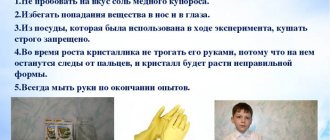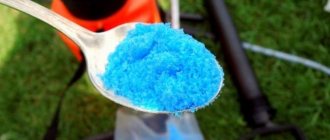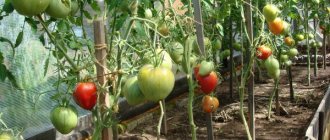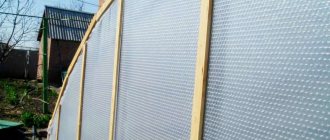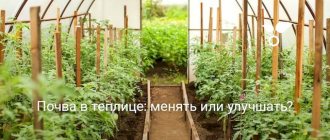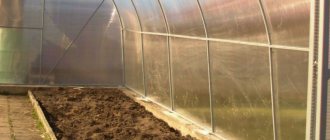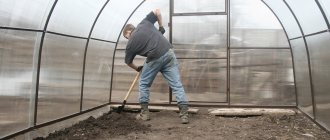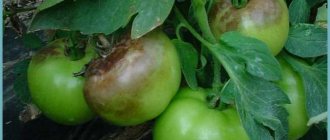Greenhouses protect plants from adverse weather conditions, but harmful microorganisms, insects and fungi easily get inside.
Treating a greenhouse with copper sulfate in spring or autumn can effectively disinfect the soil and the entire structure. Treatment is carried out after the end of the summer season or in early spring, when at least a couple of weeks remain before sowing or planting. There are many products available for disinfection at home. But copper sulfate is universal. A summer resident can treat the soil in a greenhouse with copper sulfate in the spring. The same product will help where water is powerless, that is, it will clean the inside and outside of greenhouse structures of all types.
If you do not pay enough attention to the safety of crops growing indoors, the accumulation of pathogenic flora, pest larvae and fungal spores is inevitable. This means that greenhouse plants will become sick more and more often, producing a meager, low-quality harvest.
It is especially important to monitor cleanliness and regularly treat the greenhouse with copper sulfate in the spring if the plants showed signs of bacterial or fungal diseases last season.
Copper sulfate is a highly active inorganic fungicide that has the properties of an antiseptic that works on all surfaces, as well as a microelement additive that replenishes copper deficiency in the soil. In gardening and gardening all the beneficial properties of the chemical are found.
Why treat a greenhouse?
Many people think, “I built a new greenhouse and nothing will penetrate there. I will receive a good harvest and rejoice.” But this is a fundamentally wrong judgment.
Over time, in any case, pathogenic flora will accumulate: fungal spores, pest larvae. This will lead to a decrease in the harvest or it will be of poor quality, since diseased plants mean bad fruits.
Therefore, it is very important to maintain cleanliness and monitor the condition of the soil and the covering of the greenhouse in order to prevent plant diseases.
It is necessary to carry out regular preventive treatment with an inorganic fungicide - copper sulfate. It offers a comprehensive antiseptic effect and supplies poor soil with copper.
Important: After harvesting, a lot of pathogens may accumulate in the new greenhouse, such as late blight; the lifespan is 3-4 years. Beginners think, “I’ll wash it with soap and water several times, clean it with a cloth and it’ll go away.” Unfortunately, this approach will solve the problem of dirt and unstable bacteria, which, however, are not particularly dangerous for plants. But pathogenic microorganisms will survive the winter and next season they can greatly upset an inexperienced summer resident.
In what cases is it used?
A solution of copper sulfate is used to treat tomatoes when there is a threat of late blight. However, besides this, this drug helps fight a number of other diseases:
- White spotting.
- Scab.
- Downy mildew, etc.
In addition, a solution of copper sulfate is an additional fertilizer for tomatoes. A lack of copper, especially in peaty and sandy soils, can lead to chlorosis and leaf curling. To avoid this, plants should be fed with a solution of vitriol.
Copper sulfate is used:
- Preventatively, even before late blight appears on tomatoes.
- As a means to combat existing signs of late blight.
As a preventative agent, vitriol can be used already at the stage of sowing seeds in the ground. Then the solution is used to treat the already open bed in the place where it is planted.
Precautionary measures
It doesn’t matter when copper sulfate is used and what it is used for, the most important thing is safety. At its core, it is an inorganic substance, copper sulfate in the form of a mixture of copper salt and sulfuric acid based on the chemical formula CuSO4∙5H2O. Other qualities:
- Odorless;
- Does not evaporate;
- It is characterized by pronounced hygroscopicity, can absorb and release moisture;
- Use is allowed if diluted in water.
Copper sulfate, due to the peculiarities of its chemical formula, is not as harmful as similar disinfectants created on the basis of organic components.
If the product gets on the skin, rinse it off with water. But, if it turns out to be in the gastrointestinal system, then the situation requires urgent measures:
- Thanks to an enema of a small solution of potassium permanganate, the lower parts of the intestine are washed through the anus: rectum, sigmoid colon;
- A strong laxative is used to immediately remove stool containing copper sulfate. Thus, it will not have time to be strongly absorbed into the body;
- The use of a diuretic is allowed;
- A mechanical method is used to induce a gag reflex, two fingers in the throat, or an appropriate remedy is drunk.
Advice: Copper sulfate is stored in small doses out of the reach of children and animals. But it is better to immediately use it for its intended purpose. During use, wear protective equipment: gloves, mask, goggles, thick clothing.
Release form and cost
Copper sulfate for treating tomatoes against late blight can be found on sale in the following forms:
- In the form of a dry powder, packaged in plastic bags or bottles. This packaging of vitriol is intended not only for growing vegetables, but also for other purposes (for example, builders etch moldy corners of rooms with vitriol solution during repairs, and technicians use it for galvanic treatment of copper surfaces.). Vitriol powder is packaged in bags from 100 g to 25 kg.
- In the form of a concentrate for the preparation of Bordeaux mixture. In this case, it is packaged in plastic bottles with a volume of usually about 500 ml.
The cost of vitriol is about 300 rubles per bottle of Bordeaux mixture concentrate and from 130 to 200 rubles per 1 kg of powder. The price varies depending on the quality of purification and concentration.
How to treat the greenhouse structure?
To ensure a safe place for planting, it is necessary to treat the greenhouse in the spring. Usually a 10-liter solution and 1-2 hours of painstaking work are enough. But before that, it is necessary to inspect the protective structure after winter:
- The integrity and reliability of the structure is checked;
- Contaminants are cleared.
Greenhouse processing process:
- The internal and external parts are cleaned of last year's leaves, tops and other debris. Collected and transferred to another place: materials, tools, household items;
- The interior inspection of the greenhouse continues. Large gaps are sealed with caulk as they can widen and damage the integrity of the structure. Supports are strengthened;
- Using a special product or soap, the upper part of the greenhouse is washed. At this stage, you should not use copper sulfate;
- If the inside is very dirty, then you need to wash everything thoroughly. Now you can pour boiling water over all cleaned surfaces. This will increase the impact of the upcoming treatment with copper sulfate;
- Metal structures are washed with a 9% vinegar solution. If scratches, chips, or other damage are detected, a primer is used to level the surface and secured with paint;
- The structure will dry out overnight. You can prepare a solution of vitriol in advance according to the instructions;
- Wear gloves and other protective items. A standard large bath sponge is dipped into the solution and used to wash internal surfaces and metal supports. But the use of a conventional sprayer is allowed. The latter option can speed up and simplify the work, but it is necessary to spray a copious amount of solution so that it covers the entire surface;
- After 5-6 hours or after overnight, it is necessary to ventilate the greenhouse and repeat the treatment again. During the week, it is worth doing two more disinfection procedures.
Copper sulfate for disinfection of greenhouse structures
To disinfect a polycarbonate greenhouse in the fall with copper sulfate, Bordeaux mixture is often used. Copper sulfate is mixed with lime due to the fact that vitriol solution is a highly acidic solution, which is dangerous for many plants.
Making Bordeaux mixture:
- 100 grams of vitriol should be diluted in a small amount of non-hot water, then the volume should be increased to 5 liters.
- Dilute slaked lime in 5 liters, you should get lime milk.
- Strain both solutions.
- Pour the resulting vitriol solution into the lime liquid, stirring the mixture constantly.
Thus, the result is a Bordeaux liquid, and it should have a turquoise hue.
How to treat greenhouse soil?
Unlike the design, treatment of the greenhouse soil with copper sulfate is carried out once every 4-5 years, since it cannot be oversaturated with copper. Otherwise, the fruits may be dangerous to eat, and the plants will lose their vitality.
Typically, soil treatment in a greenhouse with copper sulfate is carried out in the fall so that the product does not get on the plants. At this time, a lot of foliage and debris may accumulate, but cleaning is not necessary.
You can spray everything with a solution to kill harmful microorganisms, bacteria, fungal spores and insects.
But it is very important to realize that tillage is different. You cannot use the same concentration as in the case of greenhouse construction. Usually it is necessary to reduce the content of the active substance by half.
Tip: Spraying the bark of fruit trees and shrubs is allowed. But you can’t use it on green parts, because they will die or get damaged.
For soil treatment, a 1% solution is usually used. It is created on the basis of a glass or plastic container. For 10 liters of water you will need approximately 10 grams of chemical. The mixture is used at the rate of 2 liters per 1 square meter.
Recommended timing
If there is a need to process the elements of a polycarbonate greenhouse, then all work should be carried out after the sowing work has come to an end. For these purposes, prepare a solution of the required concentration and spray all elements of the greenhouse or greenhouse.
In most cases, the land is cultivated several weeks before the planned date of planting. During the work, there should be no plants in the greenhouse, as they may die. Particular attention should be paid to the concentration of the drug used, since there is a high probability that significant harm will be caused to the earth. It is best to follow a step-by-step work algorithm, as a result of which you can quickly achieve the desired result and effect.
When is it more profitable to carry out processing?
It is more correct to carry out the main treatment in the fall based on a temperature of + 10-15 degrees Celsius. If everything is done according to the instructions, only some larvae survive until spring.
After winter, additional preventive treatment is required, but it is ineffective against larvae. Although it also has a positive effect on the quality of the crop.
Spring treatment can help get rid of the most persistent insects, microorganisms and pathogenic flora in general. Therefore, you should not neglect this matter.
Now we have figured out the benefits of using copper sulfate on the surface of the greenhouse and in the process of disinfecting the soil. But due to the strong toxic effects, you should not use a pure chemical; it is better to rely on Bordeaux or Burgundy liquid.
Prevention
Prevention of tomatoes from late blight and other diseases is carried out in several stages.
- During the period of soil preparation for planting seedlings. The soil is watered with a light solution (30 g per 10 liters of water). A sprayer is used for processing to better distribute the drug.
- For watering planting holes during transplantation into open ground. 1 liter of solution (20 g per 5 liters of water) is poured into each well. After this, at the stage of fruit formation, the culture is sprayed with Bordeaux mixture (50 g per 6 liters of water).
Photo of proper greenhouse treatment
Advantages and disadvantages of the product
The main advantages of copper sulfate in the fight against late blight are:
- Cheapness.
- Efficiency. Neither fungi nor bacteria have time to develop resistance to such a harsh agent as copper sulfide.
- Easy to use. Even a non-specialist can make a solution and spray it on tomatoes.
- Moderate toxicity to humans. It is possible to be poisoned by vitriol, but it is difficult.
But there are also disadvantages:
- In case of an overdose, tomatoes become unsuitable for food.
- The very first rain will wash away the protective film - and the bush will remain defenseless against late blight.
- If there is an error in the dosage, you can either burn the bush or leave it defenseless.
What to replace it with?
Although vitriol solution and Bordeaux mixture are time-tested remedies, there is now a wide selection of antifungal drugs to combat late blight. These include, in particular:
- "Zineb", zinc universal fungicide. Zinc, like copper, is a heavy metal that inhibits the development of mycelium and destroys spores.
- "Previkur" - this drug is effective in the early stages of late blight. It is also used for prevention.
- "Bravo", "Kuproksat". They can be used at any stage, if the fruits themselves are not yet affected.
- “Fitosporin-M”, “Fitophtorin” are systemic biological products used at the seedling stage.
Reviews
Ivan
“I’ve been growing tomatoes for several years. When a fungus appeared on the site and the bushes became sick, I treated the bushes with various chemicals and vitriol. I didn't pay much attention to the weather. That year, I accidentally treated it with copper for fungus on a hot sunny day and all the seedlings seemed to burn out. The neighbor explained that the infection can be poisoned only late in the evening or early in the morning, so the bushes will be preserved and the efficiency will increase.”
Peter
“The tomato bushes began to wither and fall to the ground. Externally there are no signs of disease or fungi. The air temperature is average. I thought maybe the reason was that there weren’t enough vitamins. I fed it with a mineral complex, the situation practically did not change. I read that copper sulfate can be used to feed tomatoes. I dissolved a few grams of the substance in water and poured it into the ground. After a few days, all the seedlings were fresh, strong and green.”
Copper sulfate, when used correctly, will not only save your harvest, but also rid the area of fungal spores of various diseases. And the low cost, effectiveness and safety allow us to compete with imported drugs.
